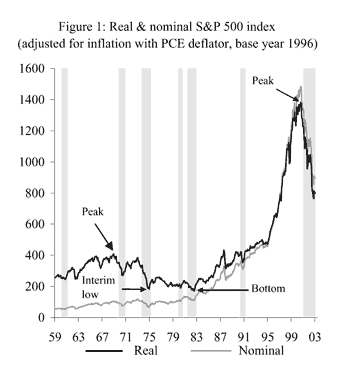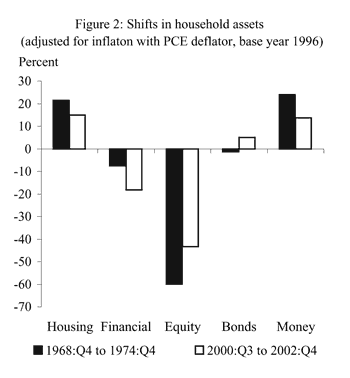As the bull market of the 1990s has turned into the bear market of the (early) 2000s, households have sharply reversed their more than decade-long trend of increasing their share of assets held in stocks. On balance, households have reallocated their assets away from stocks and toward tangible real assets, such as housing and other durable goods, as well as toward safe liquid financial assets, including cash, bank deposits, and money market mutual funds.
Financial Notes: This series supersedes Western Banking. It appears on an occasional basis and is prepared under the auspices of the Financial and Regional Research Section of the FRBSF’s Economic Research Department.
As the bull market of the 1990s has turned into the bear market of the (early) 2000s, households have sharply reversed their more than decade-long trend of increasing their share of assets held in stocks. On balance, households have reallocated their assets away from stocks and toward tangible real assets, such as housing and other durable goods, as well as toward safe liquid financial assets, including cash, bank deposits, and money market mutual funds.
This Economic Letter compares the current shift in assets with a similar shift that occurred during the long bear market of the 1970s. In particular, I ask whether the shift associated with today’s bear market is likely to last as long as the shift during the earlier one; that portfolio realignment occurred over six years, from 1968 to 1974 and was not substantially reversed until after the stock market began to rally in 1982. The answer arguably depends on some important differences between the two episodes: In the 1970s, the economic environment was characterized by low productivity growth and high inflation; today’s economy, in contrast, is expected to maintain a relatively high rate of productivity growth in the near term and low inflation. The improved fundamentals today should be more favorable for corporate earnings and stock prices and thus bring a quicker end to households’ recent shift away from stocks. In addition, the financial market innovations and regulatory changes over the past two decades that have lowered households’ transaction costs of participating in the capital markets should continue to favor stock ownership.
The bear market of the 1970s, like the current bear market, was preceded by a long period of economic expansion. From the economy’s trough in 1961:Q1 to the peak in 1969:Q4, productivity growth averaged a strong 3.4% per year and inflation remained low—in the 2% to 3% range. As Figure 1 shows, the stock market anticipated this expansion, coming off a low in 1960:Q4 and reaching a peak in 1968:Q4. Over that period, the inflation-adjusted value of the S&P 500 increased by 7.8% per year; however, households’ inflation-adjusted net worth (total assets minus total liabilities) lagged behind somewhat, growing at an average annual rate of 6.1%.

In 1970, the U.S. fell into recession, and for more than a decade, the economy and the stock market languished. Productivity growth slowed to 1.8% per year, and inflation reached into the double-digits by the end of the decade. In this environment, the stock market was a poor investment. The stock market anticipated the 1970 recession somewhat, and, after peaking in December 1968, experienced a long secular decline. The inflation-adjusted S&P 500 lost 55% of its value before hitting an interim low in December 1974, and another 6% by the time it finally reached a bottom in July 1982. Over this approximately 14-year “bear market,” the inflation-adjusted per capita net worth of households rose a meager 0.2% per year.
Based on an analysis of the allocation of household assets over the whole 14-year bear market, it appears that the realignment of household assets took about six years, from 1968 to 1974. Figure 2 indicates how the inflation-adjusted values of assets in the households’ portfolios changed during that period. (Note that stock and bond totals include direct holdings as well as indirect holdings through mutual funds and pension funds.) Total financial assets fell by 7.5%, led by a 60% drop in equities. In the face of the weak stock market, households shifted into housing, which rose by 21% in value, and into monetary assets (that include cash, bank deposits, and money market mutual funds), which gained 24% in value. Bond holdings were little changed.
By the end of the bear market, households’ financial asset holdings as a percentage of their total assets fell from 68% to 62%, while monetary assets as a percentage of total financial assets rose from 19% to 26%. On balance, households sought the greater security from tangible real assets, primarily housing, while adjusting their financial asset holdings principally away from stocks and toward the safety and liquidity of monetary assets.
The environment surrounding the historic expansion of the U.S. economy from March 1992 through March 2001 mirrors in many ways the expansion of the 1960s. After a somewhat subdued start, productivity perked up to average 2.4% per year from 1995 onward. This improved productivity growth was accompanied by strong economic growth and a surging stock market, while inflation remained relatively low. Returning to Figure 1, we see that a bottom for the (inflation-adjusted) stock market occurred in October 1990, followed by a “bull” market that accelerated rapidly after 1994, fueled by the high-tech boom. From December 1994 to its peak in August 2000, the stock market increased in value by $9.7 trillion, with the S&P 500 rising by an extraordinary 226%, or by 40% per year, for an average annual increase after adjusting for inflation of 34%. (See Lansing 2002 for a discussion of these valuations.) From 1994:Q4 to 2000:Q3, the inflation-adjusted net worth per capita of households increased by over 8% per year, with financial assets regaining prominence in households’ asset portfolios. By 2000:Q3, they comprised slightly more than 70% of the total. The market peaked in August 2000, and over the next two years, the inflation-adjusted value of the S&P 500 fell more than 43%.

Figure 2 depicts how households reallocated their assets during the current bear market (2000:Q3 to 2002:Q4). Household equity holdings (adjusted for inflation) fell by over 43%. As in the 1970s, households responded in part by shifting their wealth from financial assets to tangible real assets, with the value of housing in their portfolios rising 15%. Within their financial assets holdings, they also once again sought the safety and liquidity of monetary assets, which rose in value by 14%, with only a modest increase in bond holdings.
What is different this time around?
A major difference between the current bear market and the long bear market of the 1970s is the economic environment. During the 1970s, the growth rate of productivity fell by nearly half, while inflation reached double-digits. These factors contributed significantly to the poor performance of the stock market during that period. However, during the current bear market, productivity has held up well, while inflation is not seen to be a significant threat in the near future. In hindsight, it is clear that the sharp decline in the stock market over the past two years was driven in large measure by excessive optimism in the value of high technology to the economy, at least in the near term. This zeal likely contributed to a period of overinvestment by businesses, particularly in the computer and telecommunications sectors, which suffered substantially in the last recession and have been slow to recover. However, the long-run benefits of technological innovation to the economy should be a positive factor for corporate equities, particularly if inflation remains low. If this proves to be true, households should begin to weight stocks more heavily in their asset holdings, making it unlikely that we will see a replay of the protracted bear market of the 1970s.
Two important institutional changes since the late 1960s also have affected the composition of financial asset holdings of households. One is the growing prevalence of pension funds. Since 1960, the share of financial assets that pension funds comprise grew from a little under 7% to 27%. This growth has been due in part to the introduction of 401k, 403b, and Keogh accounts that have allowed households to make tax deductible contributions to retirement plans with significant control over the disposition of those investments. In addition, many large employers have switched from defined-benefit to defined-contribution retirement plans, again allowing households to decide how much of their retirement funds to invest in the stock market. These changes began to accelerate in the 1970s. Prior to these changes, many businesses either adopted “pay-as-you-go” pension plans with no significant contributions to the stock market, or restricted their investments to ultra-safe assets, such as government securities.
The second important institutional change is the growth in the mutual fund industry since the mid-1980s, which resulted from the changes in the retirement plans as well as from the individual small investor’s demand for an inexpensive means of acquiring a diversified investment in the capital markets. Households’ investment in stock and bond mutual funds (not including those held indirectly through pension funds) grew from about 1% of total financial assets in 1984 to 9% in 2002. To be sure, with the increased prominence of pension funds and stock and bond mutual funds, direct holdings of stocks and bonds as a share of financial assets has declined from about 37% in 1960 to 22% in 2002. Nevertheless, the potential cost advantage and portfolio diversification available through financial intermediaries facilitates household investment in stocks and bonds. Therefore, the availability of pension and mutual funds should tend to work in consort with the underlying economic fundamentals affecting households’ demand for stocks going forward.
Milton H. Marquis
Senior Economist, FRBSF, and Professor, Florida State University
Reference
Lansing, Kevin. 2002. “Searching for Value in the U.S. Stock Market.” FRBSF Economic Letter 2002-16 (May 24).
Opinions expressed in FRBSF Economic Letter do not necessarily reflect the views of the management of the Federal Reserve Bank of San Francisco or of the Board of Governors of the Federal Reserve System. This publication is edited by Anita Todd and Karen Barnes. Permission to reprint portions of articles or whole articles must be obtained in writing. Please send editorial comments and requests for reprint permission to research.library@sf.frb.org